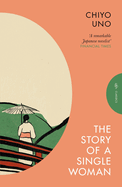
The pioneering Japanese writer Chiyo Uno (1897-1996) gained literary fame by mining her highly unconventional life; she became a published writer in 1921 after winning first prize for a short story submission to a newspaper contest. Her 1933 Confessions of Love remains a celebrated classic. The Story of a Single Woman, originally published in 1972 and translated in 1992 by author/critic Rebecca Copeland, appears in a handsome new edition, enthralling readers with Uno's unabashed candor and exhilarating independence.
Kazue is Uno's stand-in, the oldest child in a family "of substantial means." She's raised by her father's second and considerably younger wife, whom she will always consider her "mother." Witnessing her dissolute father and her long-suffering mother makes her eschew the very concept of marriage. At 13, having been betrothed to her first cousin, she lives briefly with her aunt, but any further union gets cancelled when she returns home in time for her father's death. By the age of 17, she decides "she would never marry," but that doesn't stop her from having multiple love affairs. Over the next decades, her liaisons prove complicated or fleeting, devoted or merely convenient, providing fodder for her writing life.
Uno notably composes in hybrid third- and first-person viewpoints. Kazue opens as a septuagenarian who recalls her untraditional past in third-person, but Kazue also occasionally inserts her older self over her younger as a questioning observer, cleverly creating distance with phrases like "I suppose," "it would seem," and "perhaps." Still undeniably timeless, The Story of a Single Woman presents an immutable portrait of a courageous young woman who chooses to live with forthright authenticity. --Terry Hong

